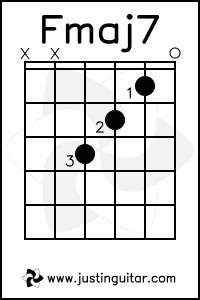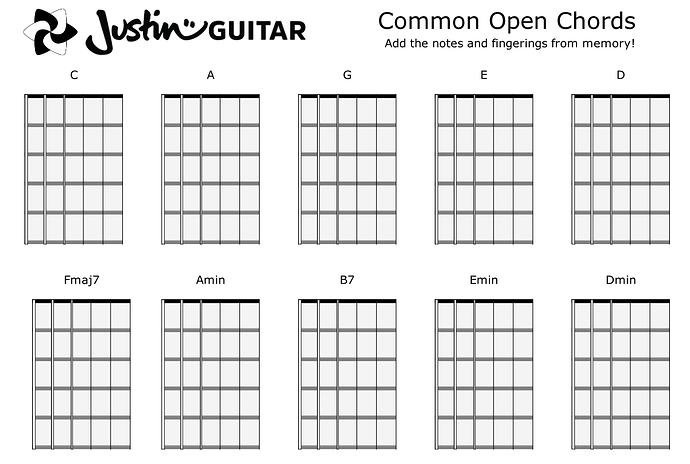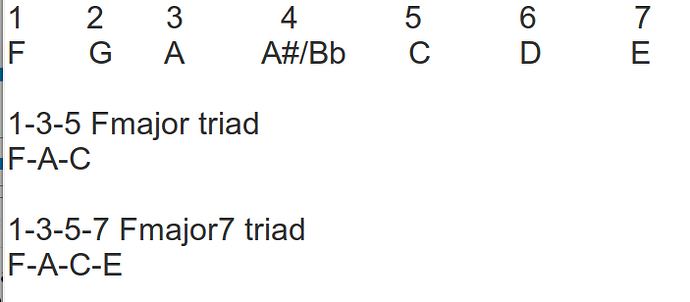I’m on PMT Mod2 where there is a blank chord chart download of “Common Open Chords.”
So the first thing my eyes to is go to the chords I don’t have memorized, like Fmajor7.
Now my “old learning” kicks in and is trying to remember major7 vs dominate7.
So I chart the chord. (If I got this wrong let me know)
I found this JG chord diagram for Fmaj7.

So a question from down in the rabbit hole.
Why are the open E and A strings muted when they are notes that comprise the Fmaj7 chord?
Good question.
You could ask similar questions:
Why is the low E string muted in a C major chord?
Why is the A string muted in D major / D minor chords?
The simple answer is that, in most playing circumstances when using simple open position chords, you want the lowest sounding note (lowest in pitch) to be the root note of the chord.
Another response could be to suggest you play all six strings when strumming Fmaj7 and see if your ears like it.
Sometimes, in certain types of play, a different bass note will be played, a note that is not the root note. And in those circumstances you will use one or other of the thicker strings. With Fmaj7 however, that is still unlikely to be open A or open E strings but much more likely to be fret 3 of the A string - the note C. This is due to the nature / function of each note within the scale.
6 Likes
Ah-hah! Yep! Now which makes me wonder how many time this same question has been asked in guitar music theory courses by those with obsessive personalities. 
I think this may make more sense when I have a better understanding of key structure and application.
I had an idea. Throw it at ChatGPT and see what it says. Pretty verbose. But look at the Chord Voicing. Wrong as it leaves an open B ringing out. It was an idea. But the muted 6th string still applies even though ChatGPT started off with a open Cmaj7.
When you play an open C chord on the guitar, you’re correct that the notes in the 1-3-5 triad that make up the C major chord are C-E-G. However, the open C chord typically involves muting or not playing the low E (6th) string. Here’s why -
Chord Voicing - The open C chord is typically played using the following fingering on the guitar:
Place your ring finger on the 3rd fret of the 5th (A) string.
Place your middle finger on the 2nd fret of the 4th (D) string.
Leave the 3rd (G), 2nd (B), and 1st (high E) strings open, which means you don’t fret them with your fingers.
Do not play the low E (6th) string. You can either avoid strumming it, or you can lightly touch it with the palm of your hand to mute it.
Chord Quality - The C major chord is made up of the notes C-E-G. When you play the open C chord, you have a C note on the 5th (A) string, an E note on the 4th (D) string, and another C note on the 1st (high E) string. The G note, which is the 5th of the C major triad, is not played in this particular voicing of the C chord.
Sound and Stability - By muting the low E string in the open C chord, you ensure that you have the root note (C) as the lowest sounding note. This gives the chord a stable and grounded sound. If you were to include the low E string, it would create a C/E chord inversion, which has a different harmonic quality and may not be what you’re aiming for when playing a basic C major chord.
In summary, muting the 6th (E) string when playing an open C chord on the guitar is a common practice to ensure that the root note (C) is the lowest sounding note, maintaining the traditional voicing and tonality of the C major chord.
Verbose indeed.
This would have sufficed.

2 Likes
Didn’t we have some sort of informal ban on ChatGPT posts, or am I thinking of another forum? 
The questiin was asked, it didn’t reach the announcement stage but could be worth discussing.
1 Like
Good grief. I lost the will to live halfway through that post! 
2 Likes
This thread reminded me that when I first started to learn guitar (many, many moons ago, in the 70s) I learned the version with a G bass note at the 3rd fret of the 6th string - a C/G chord, although I didn’t know that at the time as I didn’t learn any theory until much, much later. I understand that It was a much used voicing in pop & rock music of the time, hardly surprising because it sounds great, and is very preferable to a C with an accidental low E.
As Justin says “If it sounds good, it is good”…and clearly the reverse is true, which brings us to the answer to your question above - the open E and A strings are muted because while they don’t sound completely terrible in that chord, most people would think it sounds better without 
1 Like
@Richard_close2u You should volunteer to become a ChatGPT trainer! 
“Ok ChatGPT, nice try but wayyyyy too verbose. Let’s shorten this up a bit…” 
1 Like
(laughs) Well, I’m a bit “verbose” too. Just my nature. I tend to be a bit of a Chatty Kathy, or Chatty Kevin.
Ok - I promise I will not post any further ChatGPT answers on this forum.
Now regarding myself and my propensity to ramble? Way back in high school if I was told to write a paragraph long essay, I struggled. At best I was an average student or slightly below.
At about 25 something clicked in my brain and it all changed. Go figure. Now I enjoy writing and I enjoy helping others when I can. It’s my nature to analyse and tear concepts apart and put them back together again in a manner I personally can more easily comprehend. So my verbose writing is more about regurgitating information out in a train-of-thought sorta manner that in many way is for my own edification. Unless I’m asking specific questions, then I try to be thorough as possible.
If I bore anyone? Really? Whose twisting anyone’s arm to read my posts? No one.



Yeah, I was playing around with that last night and it has a really nice rich tone to it.
Overall this has been a good learning exercise as I’m looking at the relationship between triads, chord construction, and voicing in a new light.
1 Like
I like how Justin says at the start of the section on the chord progression, “You probably want to be just using a regular C” and then he plays C/G throughout! 
2 Likes


